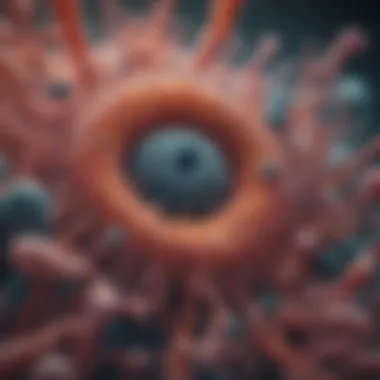Exploring PCV and PPSV Vaccines: Insights and Implications


Intro
When it comes to protecting against pneumonia, knowledge truly is power. The pneumococcal vaccines, specifically the pneumococcal conjugate vaccine (PCV) and the pneumococcal polysaccharide vaccine (PPSV), serve as vital tools in public health. Their primary function is to shield individuals from various strains of the Streptococcus pneumoniae bacteria, which can lead to significant illnesses. Yet, despite their importance, understanding these two vaccines can sometimes seem like wading through a dense fog without a flashlight.
In an era where misinformation can spread like wildfire, clarifying the distinctions between PCV and PPSV is crucial. This exploration aims to break down their composition, mechanisms, and impact, shedding light on what these vaccines really entail.
Through this informed examination, we aim to equip health professionals, researchers, and concerned individuals with the framework needed to grasp these two critical vaccines—ensuring that when the time comes, they can make informed decisions.
Key Concepts
Definition of Primary Terms
Understanding any complex topic begins with clear definitions. In our case:
- PCV (Pneumococcal Conjugate Vaccine): A vaccine that helps protect against certain types of pneumonia, meningitis, and sepsis caused by Streptococcus pneumoniae. It works by introducing a harmless piece of the bacteria into the body to prompt an immune response.
- PPSV (Pneumococcal Polysaccharide Vaccine): This vaccine targets a broader array of pneumococcal bacteria, but it functions differently. It also encourages the body to mount an immune response, but the polysaccharide molecules are made from the outer coating of the bacteria.
Both vaccines play distinctive roles in public health, especially for vulnerable groups such as children under two years old and individuals over sixty-five.
Related Concepts and Theories
While diving into the specifics of each vaccine, it’s important to grasp related concepts:
- Herd Immunity: This occurs when a significant portion of a population becomes immune to an infectious disease, thereby reducing its spread. High vaccination rates can help achieve this, leading to protection for those who cannot be vaccinated.
- Protective Immunity: A term used to describe the ability of the immune system to prevent an infectious disease after exposure or vaccination. The effectiveness of PCV and PPSV relies on this principle.
By understanding these underpinning ideas, one can appreciate not just the vaccines themselves, but the broader public health implications they carry.
Future Directions
Gaps Identified in Current Research
Despite the foundational knowledge we have, research involving pneumococcal vaccines continues to evolve. Some gaps in current studies include:
- Variability in Immunogenic Response: How do different populations respond to PCV and PPSV? More research could highlight specific demographic needs.
- Long-lasting Immunity: How long does immunity last after vaccination? Understanding the longevity of vaccine-induced immunity can shape booster recommendations.
- Variation by Region: Are certain strains more prevalent in different geographical areas that could impact vaccine effectiveness? This remains an under-explored area.
Suggestions for Further Studies
Future studies could focus on:
- Longitudinal studies analyzing the immune response over time.
- Studies exploring the combination effects of both PCV and PPSV in various populations.
- Investigations into how social factors affect vaccination rates and strategies to improve outreach in underserved communities.
It’s clear that while progress has been made in the realm of pneumococcal vaccines, there’s still valuable ground to cover. Delving deeper into these fascinating areas could translate into better health outcomes and more informed health policy decisions.
"Vaccination isn't just a personal choice; it's a societal responsibility. Understanding its nuances is paramount to effective public health."
By synthesizing the information presented, we can pave the path for enhanced understanding, leading to more robust public health initiatives and individual practices.
Overview of Pneumococcal Disease
Pneumococcal disease is a significant global health concern. This section aims to lay the groundwork for understanding both the pneumonia caused by the Streptococcus pneumoniae bacteria and the essential role of vaccination in preventing these infections. The nuances of this disease and its prevalence underscore the importance of raising awareness and promoting proactive measures against it.
Definition and Etiology
Pneumococcal disease refers to a series of infections that can range from mild to life-threatening. This disease primarily includes pneumonia, meningitis, and bacteremia. Caused by the bacterium Streptococcus pneumoniae, there are over ninety distinct serotypes responsible for various strains of infection. Notably, this bacterium is a common inhabitant of the upper respiratory tract, not always leading to illness. However, under certain conditions, such as weakened immune systems or following viral infections, it can lead to severe complications.
Epidemiology of Pneumococcal Infections
The epidemiology of pneumococcal infections reveals a troubling picture. According to data, approximately 1.6 million deaths occur annually from pneumococcal disease, particularly affecting young children and the elderly. Geographically, the impact is felt unevenly, with lower-income countries often hit harder due to limited access to healthcare and vaccines. Factors such as socioeconomic status, regional healthcare systems, and population density contribute to the patterns observed in the distribution of infections.
"Understanding the dynamics of pneumococcal disease is crucial for implementing effective public health interventions."
Clinical Manifestations
Clinical manifestations of pneumococcal disease can vary widely. Typical symptoms of pneumococcal pneumonia include high fever, cough, chest pain, and difficulty breathing. In contrast, meningitis symptoms may involve fever, headache, and sensitivity to light, among others. Early detection is critical for effective treatment, yet the diverse presentation of symptoms can complicate diagnosis. Other complications may occur, such as pleural effusion and septic shock, emphasizing the need for awareness and prompt medical attention.


Overall, having a solid grasp of pneumococcal disease paves the way for understanding the vital need for effective vaccines like PCV and PPSV. Being informed about its definition, prevalence, and manifestations helps delineate the path to public health solutions.
Pneumococcal Vaccines: An Prelims
Understanding pneumococcal vaccines is fundamental in the fight against diseases caused by the Streptococcus pneumoniae bacteria. The significance of this topic lies not only in its scientific nuances but also in its direct implications for public health. Vaccines, particularly the pneumococcal conjugate vaccine (PCV) and the pneumococcal polysaccharide vaccine (PPSV), play pivotal roles in reducing the burden of pneumonia, meningitis, and other serious infections. The quest for effective vaccination has a rich history, marked by significant milestones that have shaped current strategies and recommendations.
The vaccination landscape has evolved over the decades. Vaccines have become essential tools in preventing infections that once caused widespread illness and mortality. Understanding the benefits these vaccines provide is crucial for both healthcare providers and the general public. With increased knowledge, individuals become more empowered to make informed decisions about vaccination, ultimately boosting community immunity.
Historical Perspective on Vaccination
The history of vaccination against pneumococcal diseases goes way back. The first successful vaccine emerged in the early 20th century, primarily focusing on polysaccharide antigens. However, it took decades of research and development to create effective conjugate vaccines. The development of PCVs, introduced in the early 2000s, marked a significant breakthrough. They were designed to enhance the immune response, particularly in young children and older adults who are more vulnerable to severe infections.
Prior to the advent of these vaccines, pneumococcal disease was a leading cause of morbidity and mortality globally. The advent of the polio vaccine in the mid-20th century helped propel the vaccination movement, setting the stage for more targeted approaches to combating pneumococcal infections. The implementation of widespread immunization programs has been crucial, helping to dampen incidence rates significantly in many regions.
It's worth noting that the evolution of pneumococcal vaccines mirrors broader trends in public health regarding infectious disease control. As research progressed, scientists began to understand the complexities of antigenic variation and the need for more comprehensive vaccination strategies. The leap from polysaccharide to conjugate vaccines represented not just a technical upgrade, but a paradigm shift in how we understand human immunity and disease prevention.
Role of Vaccines in Public Health
The impact of pneumococcal vaccines on public health cannot be overstated. They have demonstrated substantial efficacy in preventing infections and reducing overall disease burden. The reduction in hospitalizations and healthcare costs associated with pneumococcal diseases illustrates how vaccines can save lives and resources.
"Vaccines are more than just medical products; they are essential instruments of public health policy that can change the fate of communities.”
Moreover, vaccination strategies contribute to herd immunity, protecting those who are unable to be vaccinated due to medical or other reasons. As communities achieve higher vaccination rates, the spread of pneumococcal bacteria diminishes, leading to fewer outbreaks and protecting at-risk populations.
In addition, the inclusion of pneumococcal vaccination in routine immunization schedules highlights its fundamental role in the holistic approach to health. Public health campaigns aimed at educating communities about the importance of vaccinations have played a critical part in fostering acceptance and compliance among diverse populations. This ongoing effort is essential not only to maintain current vaccination rates but to adapt to emerging public health challenges and innovations in vaccine technology.
In summary, the exploration of pneumococcal vaccines provides invaluable insights into historical developments, societal health advancements, and the future of infectious disease prevention. The narrative of vaccines like PCV and PPSV is one of progress, collaboration, and hope in the continuous endeavor to safeguard human health.
Pneumococcal Conjugate Vaccine (PCV)
The Pneumococcal Conjugate Vaccine (PCV) holds a significant place in modern medicine. This vaccine has been instrumental in combating pneumococcal disease, which can lead to serious conditions such as pneumonia, meningitis, and sepsis. The innovative design of PCVs showcases advancements in immunization technology and serves as a prime example of how vaccination can change the course of public health.
Composition and Mechanism of Action
PCV is crafted using a combination of polysaccharides from the capsular material of specific Streptococcus pneumoniae serotypes linked to a protein carrier. This connection enhances the immune response, prompting the body to recognize and remember the bacteria effectively. When administered, the vaccine trains the immune system to produce specific antibodies against these serotypes, which dramatically reduces the incidence of invasive diseases.
The way this mechanism works is a marvel of science. When a child or adult gets vaccinated, their immune system receives a gentle nudge, encouraging it to prepare against future encounters with this harmful bacterium. An important feature here is how PCVs help in providing herd immunity – when a significant portion of the population is vaccinated, even those who haven't received the vaccine are indirectly protected.
Indications for Use
The PCV is chiefly indicated for children under five years of age, targeting infants who are at a greater risk. However, it's not limited to younger patients. Adults, particularly those aged 65 or older and individuals with certain health conditions, also benefit from PCVs. Conditions such as chronic lung disease, heart problems, or compromised immune systems make one more susceptible to pneumococcal infections, hence, vaccination takes on a crucial role in these demographics.
Healthcare providers usually recommend PCV in the following scenarios:
- Infants starting their vaccination schedule at two months
- Young children receiving follow-up doses
- At-risk adults who require a boost to their immunity
Efficacy and Effectiveness
Research indicates that PCV dramatically reduces the rates of pneumonia caused by the targeted serotypes. Effectiveness studies have shown that PCV can reduce disease incidence by over 80% in vaccinated populations. Moreover, not just direct protection exists — studies reveal significant drops in hospitalizations for severe pneumococcal disease due to the herd immunity effect. The proactive approach of incorporating serotype replacements into the vaccine helps ensure ongoing effectiveness against emerging pneumococcal strains.
“Effective vaccination is not only a personal investment in health; it safeguards communities.”
Regular updates to vaccination guidelines and research further reinforce the robustness of PCVs against evolving strains of pneumococcus. It's a dynamic landscape where continuous monitoring enables health authorities to adapt and ensure vaccine precision.
Safety Profile and Side Effects
The safety of PCV is generally well-established. Most recipients experience minimal side effects, typically localized reactions like pain or swelling at the injection site. Other mild effects such as low-grade fever or irritability may occur but usually resolve without intervention.
Serious adverse effects are rare, which makes the overall safety profile of the PCV reassuring to both healthcare providers and patients. Parent and caretaker trust in vaccines can be strengthened when they are informed about the low likelihood of severe reactions, helping to ease concerns and combat vaccine hesitancy.
Pneumococcal Polysaccharide Vaccine (PPSV)
The Pneumococcal Polysaccharide Vaccine (PPSV) plays a critical role in the fight against pneumococcal disease, an infection caused by the Streptococcus pneumoniae bacterium. Understanding the PPSV's composition, mechanism, and applications is vital not only for healthcare professionals but also for anyone aiming to comprehend how vaccinations work to fend off serious illnesses. The importance of this vaccine cannot be overstated, particularly as vaccine uptake is essential for controlling the spread of diseases and protecting vulnerable populations.


Composition and Mechanism of Action
PPSV is composed of purified polysaccharides derived from the capsule of 23 different types of pneumococcal bacteria. This vaccine works by introducing these polysaccharides into the body, which stimulates an immune response. Specifically, upon vaccination, the immune system recognizes these polysaccharide antigens as foreign, prompting the production of antibodies. The result is an enhanced immune system that can respond more effectively to future infections by pneumococcus.
It’s worth noting that, unlike conjugate vaccines like the PCV, PPSV doesn’t induce a long-term memory immune response in younger children. Rather, it primarily helps older individuals and those with certain health conditions build immediate immunity. This is critical, considerin the populations most at risk for severe pneumococcal disease.
Indications for Use
The PPSV is generally recommended for:
- Adults aged 65 years and older.
- Individuals aged 2 to 64 years with certain chronic health conditions, such as heart disease, diabetes, or respiratory ailments.
- Adults and children with weakened immune systems, including those undergoing chemotherapy or with HIV/AIDS.
In many contexts, the PPSV is used in conjunction with the pneumococcal conjugate vaccine to give broader coverage against the strains of pneumoniae bacteria. By targeting at-risk populations and using both vaccines strategically, healthcare providers can ensure better herd immunity and protection.
Efficacy and Effectiveness
Studies indicate that PPSV offers protection against invasive pneumococcal disease, with effectiveness rates varying depending on the population being vaccinated. For adults, PPSV generally demonstrates a 60-70% efficacy against invasive diseases such as meningitis and bloodstream infections. However, it's essential to understand that its effectiveness may gradually wane over time and does not provide as robust a response in certain groups, especially the elderly or immunocompromised patients.
"Pneumococcal polysaccharide vaccination can significantly decrease the incidence of disease, especially in high-risk groups."
It’s paramount to repoort that while PPSV is effective in preventing illnesses, it may not be as effective as the conjugate vaccines in preventing pneumococcal pneumonia itself, as that effectiveness varies widely based on age and health status.
Safety Profile and Side Effects
The safety profile of PPSV is reassuring. Most individuals experience only mild side effects, which may include:
- Tenderness at the injection site.
- Mild fever.
- Fatigue.
Serious adverse reactions are rare, but they can occur. As with any vaccine, it’s crucial to monitor for allergic reactions, featuring symptoms like a rash, swelling, or difficulty breathing, albeit these incidents are infrequent.
Healthcare providers usually advise against the use of PPSV in certain situations, making a careful review of medical history essential before vaccination.
In summary, understanding the PPSV's composition, use cases, and health implications provides a clearer picture of its importance in public health strategies. By ensuring those at risk are vaccinated, we significantly improve community health and mitigate the impacts of pneumococcal disease.
Comparative Analysis of PCV and PPSV
The examination of Pneumococcal Conjugate Vaccine (PCV) and Pneumococcal Polysaccharide Vaccine (PPSV) serves as a cornerstone for developing an effective immunization strategy against pneumococcal infections. Understanding the key differences, contraindications, and cost-effectiveness is critical for health professionals and researchers alike. This analysis sheds light on how these vaccines align with public health goals and the broader fight against pneumococcal disease.
Differences in Composition and Functionality
When diving into the differences between PCV and PPSV, one can’t help but notice nuances that significantly affect their functionality.
- Composition: PCV is constructed using polysaccharides derived from multiple strains of the pneumococcus bacterium, conjugated to a protein carrier. This combination enhances the immune response, especially in younger populations.In contrast, PPSV consists of purified polysaccharide antigens from twenty-three serotypes of pneumococcus. It primarily relies on the natural immune response to polysaccharides, which may not provoke robust immunity in younger children or older adults whose immune systems have aged.
- Functionality: Due to its conjugated nature, the PCV can stimulate T-cell dependent responses, leading to immunological memory. This makes it more effective for infants and young children. On the other hand, the PPSV generates primarily antibody-mediated responses without the same level of immunological memory, making its impact shorter-lived in some groups.
Through this understanding, health professionals can strategize vaccination schedules that leverage the strengths of each vaccine for various age groups and risk profiles, ensuring higher efficacy in preventing pneumococcal disease.
Contraindications and Recommendations
Delving into contraindications and recommendations for both vaccines is essential for clinicians to administer them safely.
Contraindications for PCV and PPSV are relatively limited. Generally, individuals with a severe allergic reaction to any component of the vaccine should not receive it.
- PCV is recommended for infants and children under five years, but it may not be given to those who have had a severe allergic reaction to the vaccine components in the past.
- PPSV is often recommended for adults aged sixty-five and older and for individuals with certain chronic medical conditions. However, it should be approached cautiously in anyone with a history of allergy.
Recommendations from health organizations emphasize the importance of timely vaccination. For instance:
- PCV doses should be administered in a sequence starting from infancy, ensuring the building of immunity early in life.
- PPSV serves as a booster for those at high risk, especially older adults, to complement the protective effect of PCV.
This structured approach enhances the benefit each vaccine brings while carefully navigating patient safety.
Cost-Effectiveness Considerations
In the realm of public health, the cost-effectiveness of vaccines is always in the spotlight. The disparity in costs between PCV and PPSV might not seem immediately apparent, but a closer look reveals important insights.


- PCV tends to be more pricey due to the advanced technology needed for its production and the inclusion of multiple serotypes in a single vaccine. However, its long-term effectiveness in preventing serious pneumococcal infections can offset these higher initial costs.
- PPSV, while generally less expensive, may lead to increased healthcare costs in the longer run if it doesn’t provide sufficient protection to high-risk groups.
As policymakers weigh these factors, it becomes evident that while the upfront cost of PCV might deter some decision-makers, the potential reduction in hospitalizations and invasive disease cases presents a strong argument for its widespread use.
"Effective vaccination strategies not only reduce clinical cases but also contribute significantly to the overall economic well-being of society, making the investment in PCV and PPSV worthwhile."
Through a thorough comparative analysis of PCV and PPSV, one gains a deeper understanding of how to navigate the complexities of pneumococcal vaccination. The differences in their composition and functionality, combined with careful attention to contraindications and cost-effectiveness, pave the way for informed decisions in the ongoing efforts against pneumococcal disease.
Global Vaccination Strategies
Vaccination strategies play a critical role in managing public health, particularly when it comes to preventing diseases like pneumococcal infections. By implementing effective vaccination programs, health organizations aim to vastly reduce the incidence of pneumococcal disease within communities. Recognizing the nuances of these strategies can help us appreciate how vaccination acts as a frontline defense in public health measures, helping to curb outbreaks before they gain a foothold.
Current Recommendations and Guidelines
In various global health settings, current recommendations for pneumococcal vaccination reflect an evolving understanding of how best to protect vulnerable populations. Organizations like the World Health Organization (WHO) and the Centers for Disease Control and Prevention (CDC) establish nuanced guidelines that outline the circumstances under which the PCV and PPSV vaccines should be administered. Some key recommendations include:
- Infants and young children: It is recommended that children between 2 to 23 months receive the PCV vaccine in a series of doses. This age is crucial because young children's immune systems are still developing, making them more susceptible to infections.
- Adults aged 65 and older: For seniors, the PPSV vaccine is often suggested, especially for those with existing health issues like chronic lung disease or diabetes that increase their risk for pneumococcal disease.
- Individuals with specific health conditions: Adults with compromised immune systems, such as those undergoing chemotherapy or living with HIV, may need tailored vaccination strategies which could combine both PCV and PPSV. This approach helps maximize protection against a broader range of pneumococcal strains.
By adhering to these guidelines, public health officials can effectively target vaccination efforts to those who are at the highest risk. This targeted approach, bolstered by ongoing epidemiological assessments, ensures that resources are allocated where they can have the greatest impact.
Challenges and Barriers to Vaccination
Despite the advantages of pneumococcal vaccines, several challenges hinder vaccination uptake globally. Understanding these barriers is essential for designing interventions that can effectively promote vaccine acceptance and administration. Some notable challenges include:
- Socioeconomic factors: In low-income neighborhoods, accessing vaccines can be challenging. This might be due to transportation issues or a lack of nearby clinics providing the vaccines, highlighting the need for improved healthcare infrastructure.
- Misinformation and distrust: There can be a reluctance to get vaccinated due to misinformation circulating in communities. This misinformation often spreads through social media platforms like Facebook or Reddit, leading to hesitancy around vaccine safety and efficacy.
- Cultural beliefs: Cultural attitudes towards vaccines can also discourage uptake. In some communities, traditional medicine practices may be preferred over modern vaccination, creating additional hurdles for healthcare providers.
- Public health policy gaps: In certain regions, there may be insufficient public health policies that promote vaccination as a priority, leading to a decrease in available education around the importance of pneumococcal vaccines.
Addressing these barriers is a multi-faceted endeavor, requiring collaboration between healthcare providers, policymakers, and local communities. It’s imperative that strategies be developed to not only enhance access to vaccines but also foster a more informed and trusting relationship between the public and health authorities.
Vaccination is not just an individual choice; it's a community responsibility. A safer society emerges when everyone participates in vaccination efforts.
Future Directions in Pneumococcal Vaccination Research
Research in pneumococcal vaccination is essential as it holds the promise of understanding and addressing the evolving challenges posed by pneumococcal disease. Vaccine technology has advanced considerably in past years, necessitating an exploration of future innovations that could lead to better immune responses and broader protection against various strains of the bacteria. The pursuit of enhanced vaccines is particularly crucial in the face of rising antibiotic resistance and shifting pneumococcal serotypes. The importance of delving into future directions is not only about better vaccines but also about tailoring these interventions to suit diverse population needs well.
Innovative Vaccine Technologies
The quest for innovative vaccine technologies isn't just a technical challenge but a call to arms in a public health narrative that demands fresh, reliable solutions. Recent trends show a push for developing conjugate vaccines that go beyond what PCV and PPSV offer. New technologies include mRNA vaccines, which have gained notoriety during the COVID-19 pandemic. These vaccines work by instructing cells to produce harmless components of the pathogen, prompting the immune system to respond without facing the full brunt of the disease. The potential for mRNA technology applies to pneumococcal disease as well, where rapid development and high efficacy could shift the current landscape of vaccination.
Another area ripe for innovation lies within nanoparticle-based vaccines. These vaccines leverage tiny particles to present multiple pneumococcal antigens in a way that mirrors natural infections, potentially resulting in stronger, longer-lasting immunity. With the promise of reduced dosage and side effects, these can open doors to improved compliance and coverage, especially in areas that currently battle low vaccination rates. The ability to produce these vaccines in a cost-effective manner is also crucial, considering the economic constraints many healthcare systems face.
Potential Impact of Research on Policy
Scientific discoveries in the realm of pneumococcal vaccination carry profound implications for public health policy. As new vaccines emerge, it becomes pivotal for health authorities to integrate these findings into vaccination schedules, ensuring populations benefit from the latest advancements. Policy adaptations must consider efficacy rates, safety profiles, and economic factors surrounding new vaccines. Failure to update guidelines in line with scientific research can hinder the fight against pneumococcal disease and leave vulnerable populations exposed.
To navigate these changes thoughtfully, collaborations between researchers, public health officials, and policymakers are necessary. Such partnerships ensure that decisions are driven by data, paving the way for informed immunization strategies. Increased vaccination coverage and an emphasis on continuous research monitoring are key instruments for success. Keeping a sharp eye on emerging data allows for responsive adjustments to programs - an agile approach, that has the potential of transforming public health outcomes.
"Investing in future vaccine research not only safeguards the current population but sets the foundation for the health of generations to come."
As we venture forward, the need for investment in pneumococcal vaccine research cannot be overstated. The future promises a landscape rich with potential, where innovative technologies and informed policies can forge a path to a society less burdened by this preventable disease.
End
The conclusion of this article serves as a vital synthesis, encapsulating the essential knowledge surrounding PCV and PPSV vaccines. It distills the complexities of pneumococcal vaccination into coherent takeaways, emphasizing the dual role of these vaccines in public health and individual protection. The significance of this section cannot be overstated; it not only summarizes the key points but highlights the implications of ongoing advancements in vaccine technology and public health strategies.
Summary of Key Findings
In essence, this exploration has revealed several critical insights:
- Differentiation of vaccines: The PCV and PPSV vaccines, while both aimed at averting pneumococcal disease, possess distinct structures and mechanisms, which influence their efficacy and applications.
- Target populations: Each vaccine is tailored for specific demographics; PCV is often recommended for children and high-risk groups, while PPSV is particularly advantageous for older adults.
- Public health impact: The successful implementation and uptake of these vaccines contribute significantly to reducing incidences of pneumococcal infections globally, reinforcing community health and wellness.
"Vaccination against pneumococcal disease showcases not only individual protection but also broader public health achievements."
Importance of Continued Research and Monitoring
The ever-evolving landscape of infectious diseases necessitates persistent scrutiny and research. To maintain and improve vaccine strategies against pneumococcal disease, the following elements must be prioritized:
- Adaptation to new data: Ongoing research is crucial for adapting vaccination programs in response to emerging strains of the pneumococcus bacterium.
- Safety monitoring: Continued surveillance for any adverse effects or contraindications is essential to assure public trust and maximize vaccine uptake.
- Engagement with public health policies: The findings from ongoing studies should inform policy-makers, enabling them to update vaccination guidelines and strategies that reflect the latest scientific understanding.
In summary, the conclusion reiterates that sustained research, vigilant monitoring, and adaptive strategies are imperative for enhancing the effectiveness of pneumococcal vaccination efforts. Individuals, healthcare professionals, and public health entities alike must stay informed and proactive in this endeavor, ensuring the health of communities now and in the future.



